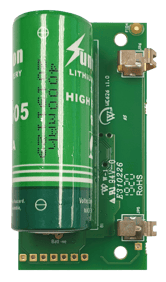Over our next two articles introducing the Connect Monitor, David Howell, Wellington's Chief Technical Officer tells us about the real-world design considerations for the Connect Monitor's battery, starting off with the energy budget.
As the labour cost of replacing a low-cost IoT device is significantly higher than the price of the device itself; the battery must deliver the longest possible life while also producing the best possible device performance under real-world conditions.
Our target for Connect Monitor was to provide 5+ years of battery life in beverage cooler applications, with all functions operating at maximum. In many cases, well above that life expectancy will be achieved.
Connect Monitor has the intelligence to extend its own life by turning functions off or down when they are not needed, such as when the store is closed, the cooler is warehoused, or the device is not installed.
Besides, customers can decide to further extend the life by permanently disabling functions which they don’t need. However, we wanted to make sure that beverage customers could be confident of reaching the five-year operation mark in all circumstances.
In selecting our battery, firstly, we started with our power budget. Connect Monitor has several sensors, a microprocessor, and a Bluetooth radio. By far the most power-hungry of these is the Bluetooth radio. We use a Bluetooth 4 radio in Connect Monitor, which is much more efficient than the more common Bluetooth 2 seen in headsets and similar devices.
The latest Bluetooth version, Bluetooth 5, is more energy-efficient again. Although Connect Monitor’s Bluetooth chip is compatible with version 5, we opted not to use it; as many customers and consumers use older mobile phones or handhelds that are not compatible, and this is likely to remain true for the foreseeable future.
Many manufacturers of beacon type devices make significant compromises on Bluetooth performance to be able to quote a long battery life. We learned with our “Connect SCS” controller that strong signal strength and a high beacon advertising rate are critical for reliable asset tracking, data collection, and for good user experience. In particular, it’s essential to keep the advertising interval for each beacon type to less than one second, as most Android phones default to scanning for only one second out of every 4. If the beacon advertises less than once a second, the phone may be asleep every time it advertises, leading to extremely long detection times and poor user experience.
Additionally, many of our customers are eager to use Connect SCS and Connect Monitor devices to enable beacon-based proximity marketing campaigns but have not yet settled on a strategy. So to allow the broadest range of options, we enable both iBeacon and Eddystone beacon types simultaneously (changing beacon settings once devices are deployed in the field is a major effort) together with broadcasting the Wellington Connect tracking signal, this meant our energy budget needed to allow for a transmission every 0.3 seconds to give each beacon type an advertising frequency of better than 1 second.
If customers know which beacon type they want to use, they can choose to turn off the other one and run their preferred one even faster, giving a superior user experience without loss of battery life. Our iProximity marketing team can provide valuable advice on this.
 Starting with this advertising rate target, and then selecting the most energy-efficient Bluetooth radio, sensors and microprocessor available, determining the sensing rate necessary to give a good picture of cooler behaviour, doing extensive testing to find out how much power the components actually used in real life, and leaving a little up our sleeve for production tolerance, we found that our energy budget was a minimum of 3500 milliamps per hour (mAh) at 3 volts (V). This is a lot of energy for a small device.
Starting with this advertising rate target, and then selecting the most energy-efficient Bluetooth radio, sensors and microprocessor available, determining the sensing rate necessary to give a good picture of cooler behaviour, doing extensive testing to find out how much power the components actually used in real life, and leaving a little up our sleeve for production tolerance, we found that our energy budget was a minimum of 3500 milliamps per hour (mAh) at 3 volts (V). This is a lot of energy for a small device.
Connect Monitor has an advanced (patent applied for) door sensing technology which allows the freedom to mount it some distance from the door, and we can securely screw it to the wall. This gives us the freedom to provide a generously sized, and therefore heavy battery, without worrying about the device falling off; as tape-secured devices so often do.
Next time we explore the design considerations for battery selection.
